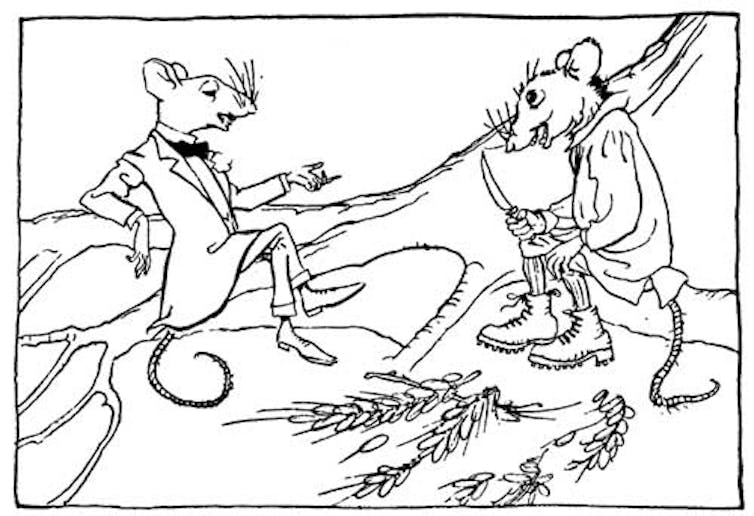Dusty barns, gleaming stables and damp basements. These are all places where you might find a house mouse — or a member of my research team.
I’m an evolutionary biologist, and my lab at Drexel University studies wild house mice. With help from Philly residents, we are collecting mice from high-rises and rowhomes to learn more about the impacts of city living on house mice. In short, we want to know whether there is any scientific basis to “The Town Mouse and the Country Mouse” fable in which the cousins eat differently based on where they live.
Cities are hotter and they have a lot of people living in high densities, which means more trash and usually more pollution. This can affect how species that live in cities evolve. Cities are also dominated by artificial habitats such as sidewalks, high-rises and subways rather than open fields and forests.
We are interested in many possible changes, but especially in whether the many differences between urban and rural environments translate into genetic differences between city mice and country mice, such as which versions of genes related to metabolism are more common.
To find the answers, we sequence the mice’s genomes. With that data, we can answer a variety of questions, such as: Are city mice more or less genetically diverse than country mice? Are there regions of DNA, the molecule that encodes genetic information, that are consistently different between urban and rural mice? If so, what are the functions of genes in those regions?

Why study house mice?
One reason we study house mice is because they are so widespread. European colonizers brought house mice to the Americas around 500 years ago. The rodents have now spread into many different climates and habitats across North and South America in most places that humans live, including Philadelphia.
Though small in size, house mice have made immeasurable contributions to genetics and medicine. They are mammals like humans, but house mice reproduce quickly and are relatively easy to breed and maintain. In fact, part of why scientists adopted mice early on as a model system is because people were already breeding “fancy mice” as pets. As a result, methods for keeping and breeding them were known.
Mice have many visible traits for geneticists to study. My team wants to know more about the genes and traits that have contributed to their ability to thrive in a variety of environments. The work we do with wild house mice also feeds back into work with laboratory mice and biomedical research. The house mice found in attics and cabinets are the same species that are studied in labs, but they are more genetically diverse than laboratory strains. Our project will generate whole genome sequences from many wild mice, and that data can help scientists who study traits and diseases.
Tips for catching mice
I previously worked on a large project studying how house mice have adapted to different climates in the Americas. For that project, I went to many, many farms throughout the eastern United States and became very good at catching mice in barns.
Starting this project with a focus on cities was a new challenge. First, our team had to find Philly residents who wanted us to trap their mice. We spent a lot of time spreading the word on social media, talking to friends and posting flyers.
We talked to many Philadelphians who were frustrated with trying to rid their homes of mice. Some had videos of house mice avoiding the traps they had set or stealing the bait and running away. We share this frustration and feel it keenly. In some cases, it took us many days to catch a single mouse in an apartment.
Part of the reason is because many Philadelphia houses are old. This means they are often full of character – and holes that give mice great places to hide. Luring the mice out of their nests and into our traps is difficult. We had the most success with peanut butter bait, which has a strong and very appealing odor for mice. But mice are omnivores, eating a diverse diet that includes insects. We have heard many stories from community members who used bait such as chocolate, cereal, cookies and even bacon bits.
What’s next
We hope to start sharing results over the next two years. We are working in three cities — Philadelphia, New York City and Richmond, Virginia — and have completed our first collections. Now we need to generate and analyze genetic data, so we are very busy in the lab.
We are extracting DNA, as well as another form of genetic material called RNA, from different tissues. With the DNA we will study how much genetic variation exists within city mouse populations, and whether there are genetic differences between urban and rural mice. The RNA will help us understand how differences in DNA translate into differences in metabolism, physiology and other cellular processes.
We will also look to see whether there are differences in traits. For example, we will measure their skulls and skeletons. We will sequence the DNA of the microbes in their digestive system to learn about their gut microbiomes, the collection of bacteria that live in their digestive system, and use stable isotope analysis to identify any differences in their diets. Stable isotope analysis of diet uses the ratios of naturally occurring atoms of elements such as carbon and nitrogen to determine what types of food an organism has eaten.
Cities are full of wildlife. Learning about how cities shape the evolution of mice may help us find better ways to manage mouse populations and other urban wildlife while also better understanding evolution.
Before you go...
Please consider supporting Technical.ly to keep our independent journalism strong. Unlike most business-focused media outlets, we don’t have a paywall. Instead, we count on your personal and organizational support.
Join our growing Slack community
Join 5,000 tech professionals and entrepreneurs in our community Slack today!





